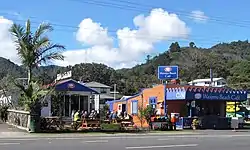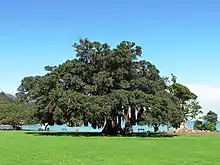Waiomu | |
|---|---|
 Waiomu Beach Café | |
| Coordinates: 37°01′37″S 175°30′58″E / 37.027°S 175.516°E | |
| Country | New Zealand |
| Region | Waikato |
| District | Thames-Coromandel District |
| Ward | Thames ward |
| Community Board | Thames Community |
| Electorates | |
| Government | |
| • Council | Thames-Coromandel District Council |
| Area | |
| • Total | 3.83 km2 (1.48 sq mi) |
| Population (June 2023)[2] | |
| • Total | 380 |
| • Density | 99/km2 (260/sq mi) |
Waiomu is a settlement on the west coast of the Coromandel Peninsula of New Zealand, between Tapu to the north and Te Puru to the south. State Highway 25 runs through it.[3]
Waiomu Kauri Grove Walk is a hiking trail to a stand of New Zealand kauri trees in Coromandel Forest Park.[4]
In the hills above Waiomu lays the abandoned Monowai mine.[5] Parts of it can be seen on the Waiomu Kauri Grove Walk.
Demographics
Waiomu is described by Statistics New Zealand as a rural settlement. It covers 3.83 km2 (1.48 sq mi)[1] and had an estimated population of 380 as of June 2023,[2] with a population density of 99 people per km2. Waiomu is part of the larger Thames Coast statistical area.[6]
| Year | Pop. | ±% p.a. |
|---|---|---|
| 2006 | 384 | — |
| 2013 | 339 | −1.76% |
| 2018 | 354 | +0.87% |
| Source: [7] | ||

Waiomu had a population of 354 at the 2018 New Zealand census, an increase of 15 people (4.4%) since the 2013 census, and a decrease of 30 people (−7.8%) since the 2006 census. There were 144 households, comprising 171 males and 186 females, giving a sex ratio of 0.92 males per female, with 39 people (11.0%) aged under 15 years, 33 (9.3%) aged 15 to 29, 156 (44.1%) aged 30 to 64, and 123 (34.7%) aged 65 or older.
Ethnicities were 79.7% European/Pākehā, 28.8% Māori, 2.5% Pacific peoples, 0.8% Asian, and 1.7% other ethnicities. People may identify with more than one ethnicity.
Although some people chose not to answer the census's question about religious affiliation, 52.5% had no religion, 34.7% were Christian and 0.8% had other religions.
Of those at least 15 years old, 33 (10.5%) people had a bachelor's or higher degree, and 84 (26.7%) people had no formal qualifications. 24 people (7.6%) earned over $70,000 compared to 17.2% nationally. The employment status of those at least 15 was that 93 (29.5%) people were employed full-time, 48 (15.2%) were part-time, and 9 (2.9%) were unemployed.[7]
References
- 1 2 "ArcGIS Web Application". statsnz.maps.arcgis.com. Retrieved 29 August 2022.
- 1 2 "Subnational population estimates (RC, SA2), by age and sex, at 30 June 1996-2023 (2023 boundaries)". Statistics New Zealand. Retrieved 25 October 2023. (regional councils); "Subnational population estimates (TA, SA2), by age and sex, at 30 June 1996-2023 (2023 boundaries)". Statistics New Zealand. Retrieved 25 October 2023. (territorial authorities); "Subnational population estimates (urban rural), by age and sex, at 30 June 1996-2023 (2023 boundaries)". Statistics New Zealand. Retrieved 25 October 2023. (urban areas)
- ↑ Harriss, Gavin (March 2022). "NZ Topo Map" (Map). Waiomu, Waikato.
- ↑ "Waiomu Kauri Grove Walk". New Zealand Department of Conservation. Retrieved 29 August 2022.
- ↑ "Monowai Mine". Hudson Institute of Mineralogy. Retrieved 22 December 2023.
- ↑ 2018 Census place summary: Thames Coast
- 1 2 "Statistical area 1 dataset for 2018 Census". Statistics New Zealand. March 2020. 7010687, 7010688 and 7010693.